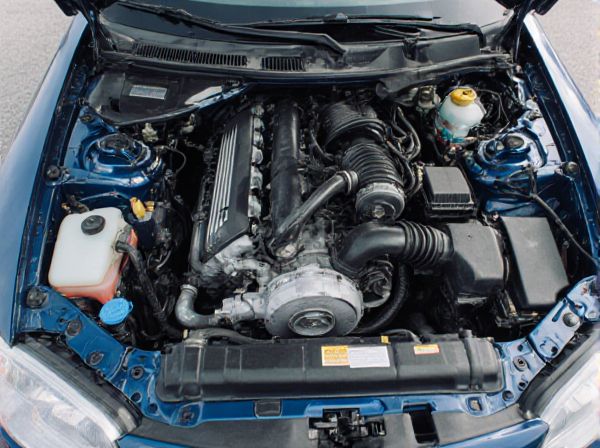
Photo illustration: Longitudinal Engine vs Transverse Engine
A longitudinal engine is mounted parallel to the vehicle's length, typically found in rear-wheel-drive and all-wheel-drive vehicles, offering better balance and power distribution for performance driving. Transverse engines are placed perpendicular to the vehicle's length, predominantly in front-wheel-drive cars, maximizing interior space and improving fuel efficiency. Choosing between the two depends on your vehicle's design priorities and driving preferences.
Table of Comparison
| Feature | Longitudinal Engine | Transverse Engine |
|---|---|---|
| Orientation | Engine aligned front-to-back (parallel to vehicle length) | Engine aligned side-to-side (perpendicular to vehicle length) |
| Common Use | Rear-wheel drive (RWD), all-wheel drive (AWD), luxury and performance cars | Front-wheel drive (FWD), compact and economical vehicles |
| Drivetrain Layout | Direct power transfer to rear wheels | Power transferred to front wheels |
| Packaging | Taller engine bay, more space needed lengthwise | More compact, saves space under the hood |
| Maintenance | Easier access to transmission and rear components | Can be cramped due to compact layout |
| Handling | Better weight distribution, enhanced performance handling | More front-heavy, affects handling dynamics |
| Fuel Efficiency | Typically lower, due to drivetrain losses and weight | Higher fuel efficiency due to lighter drivetrain |
| Examples | BMW 3 Series, Mercedes E-Class | Honda Civic, Toyota Corolla |
Introduction to Engine Layouts
Longitudinal engines are mounted parallel to the vehicle's length, providing balanced weight distribution and optimal performance in rear-wheel-drive and all-wheel-drive systems. Transverse engines are positioned perpendicular to the vehicle's length, maximizing space efficiency and commonly used in front-wheel-drive cars for compact design and improved fuel economy. Each engine layout influences drivetrain configuration, handling characteristics, and packaging constraints in automotive design.
What is a Longitudinal Engine?
A longitudinal engine is an internal combustion engine mounted with the crankshaft aligned front to back, parallel to the vehicle's length, commonly found in rear-wheel-drive and all-wheel-drive cars. This configuration enhances drivetrain efficiency by providing a direct connection to the transmission and differential, often resulting in better weight distribution and performance handling. Longitudinal engines are preferred in performance and luxury vehicles due to their ability to accommodate larger engines and support advanced drivetrain layouts.
What is a Transverse Engine?
A transverse engine is an engine mounted with its crankshaft oriented perpendicular to the vehicle's direction of travel, commonly used in front-wheel-drive cars to maximize space efficiency and improve weight distribution. This layout allows for a more compact engine bay, facilitating better cabin space and easier maintenance access. Transverse engines often work seamlessly with transaxle designs, integrating the transmission and differential into a single unit for enhanced drivetrain efficiency.
Key Differences Between Longitudinal and Transverse Engines
Longitudinal engines are mounted parallel to the vehicle's length and typically found in rear-wheel-drive cars, optimizing power delivery to the rear wheels for improved performance and handling. Transverse engines are mounted perpendicular to the vehicle's length, commonly used in front-wheel-drive cars, allowing for a more compact engine bay and better space efficiency. The key differences include drivetrain layout, packaging benefits, and impact on vehicle dynamics, with longitudinal setups favoring performance and transverse designs enhancing interior space.
Advantages of Longitudinal Engine Layout
The longitudinal engine layout offers improved weight distribution by aligning the engine with the vehicle's length, enhancing handling and balance, especially in rear-wheel-drive cars. This configuration facilitates easier powertrain integration for performance vehicles, allowing for more efficient torque transfer and better drivetrain durability. Additionally, it often enables larger engine options and better cooling efficiency due to the increased space within the engine bay.
Advantages of Transverse Engine Layout
The transverse engine layout offers compact packaging, allowing more efficient use of engine bay space which results in increased cabin room and better interior design flexibility. It enables simpler and lighter drivetrain configurations for front-wheel-drive vehicles, improving fuel efficiency and reducing manufacturing costs. Enhanced weight distribution over the front axle also contributes to improved traction and handling in everyday driving conditions.
Performance Comparison: Handling and Power Delivery
Longitudinal engines typically offer superior handling and power delivery in rear-wheel-drive vehicles due to better weight distribution along the car's length, enhancing balance and stability during high-speed maneuvers. Transverse engines, commonly found in front-wheel-drive setups, provide compact packaging and reduced drivetrain losses but may introduce torque steer and less optimal weight balance, affecting handling precision. Performance-focused vehicles often prefer longitudinal engines for improved power transfer and dynamic driving experience, while transverse engines prioritize efficiency and space-saving.
Impact on Vehicle Design and Interior Space
Longitudinal engines, positioned front-to-back, often enable more balanced weight distribution, benefiting handling and allowing for larger engine options in rear-wheel-drive or all-wheel-drive layouts. Transverse engines, mounted side-to-side, maximize cabin space by reducing engine bay length, which enhances interior legroom and allows for more compact front-end designs, especially in front-wheel-drive vehicles. The choice between these layouts significantly influences vehicle architecture, with longitudinal setups favoring performance and packaging flexibility and transverse setups prioritizing interior volume and efficient space utilization.
Maintenance and Repair Considerations
Longitudinal engines typically offer easier access to components like the clutch and transmission, simplifying maintenance and reducing labor costs for repairs. Transverse engines, common in front-wheel-drive vehicles, often have more compact layouts that can complicate servicing tasks due to tighter spaces and integrated systems. Mechanics may face higher diagnostic and repair times with transverse configurations, affecting overall maintenance efficiency and cost.
Which Engine Layout is Best for You?
Choosing between a longitudinal engine and a transverse engine depends on your vehicle's intended use and performance preferences. Longitudinal engines, typically found in rear-wheel-drive and all-wheel-drive cars, offer better weight distribution and handling, making them ideal for sports and luxury vehicles. Transverse engines are more compact and efficient, commonly used in front-wheel-drive cars, providing better fuel economy and maximizing interior space for everyday commuting.
 caratoz.com
caratoz.com